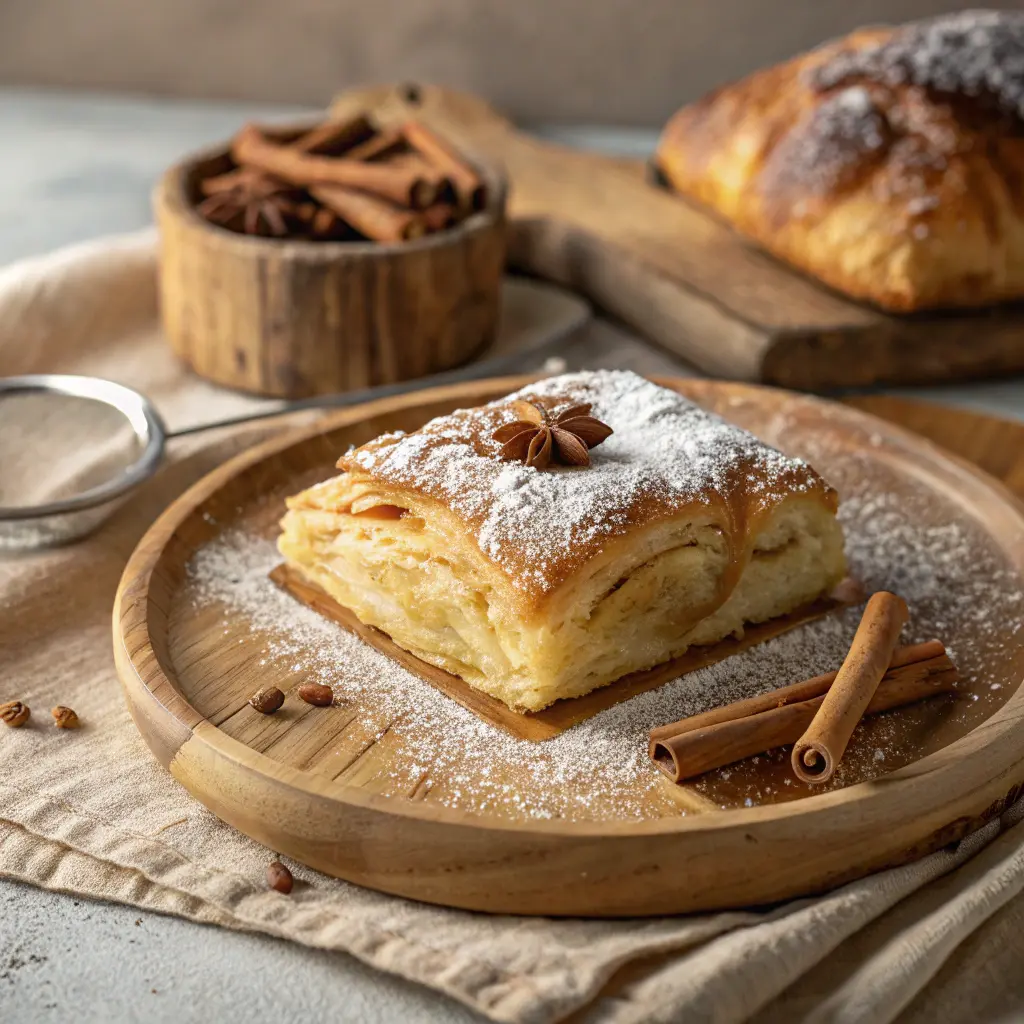Few desserts capture the heart (and the taste buds) quite like the Golden Bougatsa Delight. This creamy, flaky Greek pastry is more than just a sweet treat — it’s a warm hug wrapped in buttery phyllo dough. In this article, we’ll dive deep into everything you need to know about this iconic dish: its cultural roots, ingredients, step-by-step recipes, global variations, and even how it compares to similar pastries. We’ll also explore what truly makes it “golden” and answer some of the most asked questions online about it.
If you’ve never heard of Golden Bougatsa Delight or only tasted a store-bought version, get ready to fall for the real thing. By the end of this guide, you’ll be craving your first homemade bite!
Introduction to Golden Bougatsa Delight
What is Golden Bougatsa Delight?
Let’s set the record straight — Golden Bougatsa Delight isn’t your average pastry. It’s a beloved Greek dessert made from thin, crisp layers of phyllo dough filled with a smooth, lightly sweet semolina custard. When baked to golden perfection and dusted with powdered sugar and cinnamon, the result is pure bliss.
Often enjoyed for breakfast or as an afternoon snack in places like Thessaloniki or Athens, Bougatsa is more than food — it’s a nostalgic experience. The “golden” in its name refers not only to its beautifully browned crust but also to its elevated status among Greek desserts.
This dish stands proudly alongside other traditional Greek sweets like baklava, galaktoboureko, and melomakarona, but what sets it apart is its flaky lightness paired with a creamy, comforting center. Plus, it’s super versatile — enjoyed warm, cold, or even re-crisped the next day.
And hey, don’t confuse it with savory bougatsa! That one’s stuffed with cheese or minced meat. This version? It’s all about that custard heaven.
Origin and Cultural Significance in Greek Cuisine
Dating back to the Byzantine era, Bougatsa has evolved from a humble street snack into a national treasure. It originated in the northern Greek regions, especially Serres and Thessaloniki, where bakeries still serve it fresh every morning.
The name itself comes from the Ottoman word pogatsa, highlighting its deep historical roots. Over centuries, Greek artisans made it their own — perfecting the custard, refining the phyllo, and giving birth to what we now cherish as the Golden Bougatsa Delight.
In Greece, it’s not unusual to see people grabbing it on the go — folded in wax paper, steaming hot from the oven. It’s woven into daily routines, family traditions, and even childhood memories. Simply put, this golden delight is a flavorful symbol of Greek heritage.
Ingredients That Make Golden Bougatsa Delight Irresistible
Traditional vs. Modern Ingredient Choices
When it comes to the Golden Bougatsa Delight, the magic truly begins with its ingredients. Traditional Greek bougatsa calls for just a handful of simple staples — but don’t be fooled. Each plays a vital role in building the rich layers of flavor and texture this dessert is famous for.
The classic version includes:
- Phyllo dough (paper-thin and flaky)
- Semolina (used to create a creamy custard)
- Whole milk
- Eggs
- Butter
- Vanilla extract
- Powdered sugar and cinnamon for topping
Modern twists have introduced ingredients like orange zest, honey, or even a hint of mastiha (Greek resin spice). You’ll also find vegan and gluten-free versions that swap in almond milk, cornstarch, or coconut oil.
What makes it so irresistible? It’s that contrast — the crispy, golden shell giving way to a soft, custard-filled center. It’s sweet but not overpowering, making it perfect for breakfast or dessert.
Fun fact: The custard is cooked first and then baked again within the dough, locking in all that creamy goodness.
Want more ideas for indulgent desserts? Try these decadent Strawberry Cheesecake Stuffed Donuts — another sweet treat with a soft interior and crisp exterior. They make a great pairing with Golden Bougatsa Delight for your next brunch spread!
Healthier Variations: Can Bougatsa Be Made Guilt-Free?
Absolutely! While the traditional recipe is indulgent, there are plenty of ways to lighten it up without sacrificing flavor. Here’s how:
- Use low-fat milk or a plant-based alternative like oat or almond milk.
- Swap white sugar for honey or maple syrup in the custard.
- Choose olive oil spray instead of brushing on butter between phyllo layers.
- Use fewer phyllo sheets or opt for whole wheat versions.
Even a healthier version keeps that signature “golden” crust and dreamy filling. It’s proof that the Golden Bougatsa Delight can be both comforting and clean!
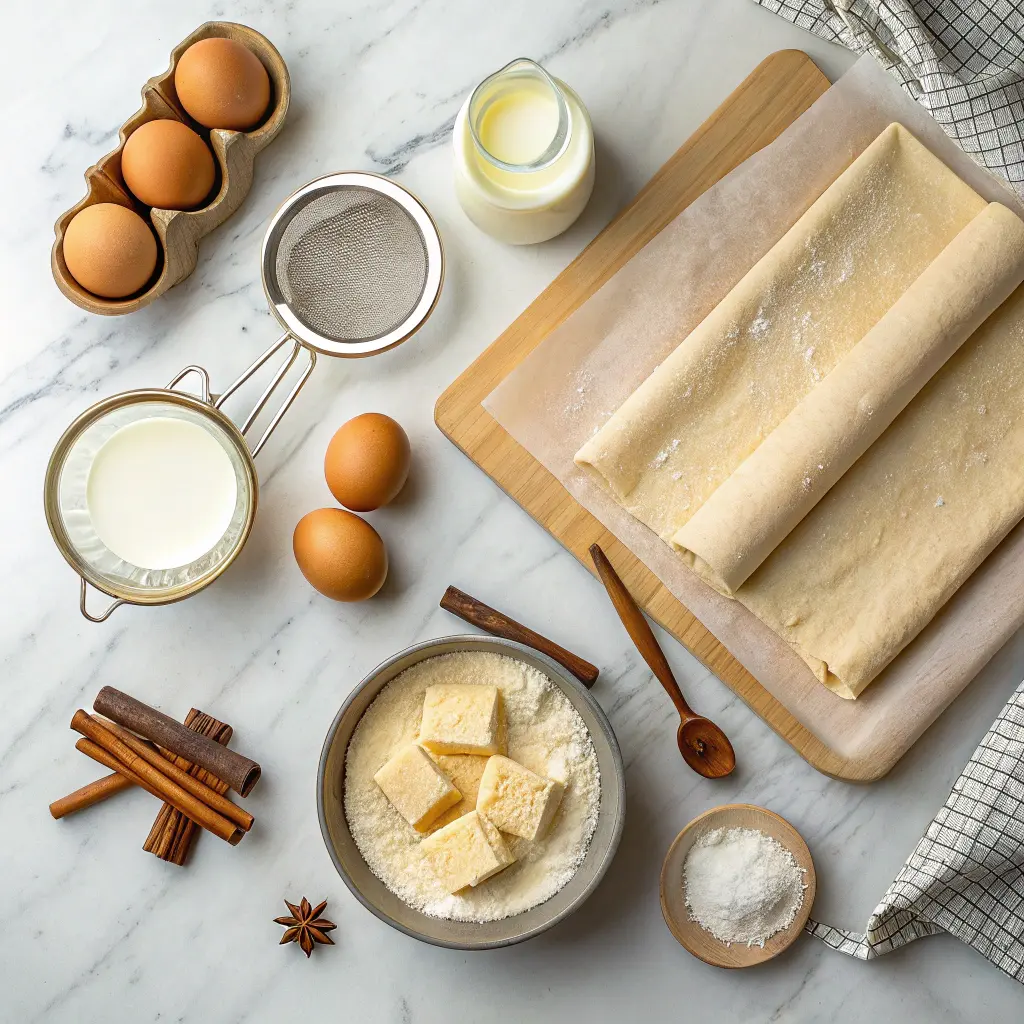
How to Make Golden Bougatsa Delight at Home
Step-by-Step Bougatsa Recipe
Ready to whip up your own Golden Bougatsa Delight from scratch? Let’s roll — literally!
Ingredients You’ll Need:
- 1 package phyllo dough (thawed if frozen)
- 4 tbsp unsalted butter (melted)
- ½ cup fine semolina
- 2 cups whole milk
- ¾ cup sugar
- 2 eggs
- 1 tsp vanilla extract
- Cinnamon and powdered sugar (for topping)
Instructions:
- Make the custard: In a saucepan, heat milk and semolina over medium heat, stirring constantly. Once thickened, remove from heat.
- Add sugar and eggs: Whisk eggs with sugar and vanilla, then gradually stir into the warm semolina mix. Let it cool.
- Layer the phyllo: Brush melted butter onto a baking dish. Layer 4-5 phyllo sheets, brushing each with butter.
- Fill and fold: Pour custard into the center, fold excess phyllo over the top, then layer another 3-4 sheets on top. Tuck edges in.
- Bake: Preheat oven to 350°F (175°C). Bake for 35–40 minutes or until golden brown.
- Dust and serve: Let cool slightly, then top with powdered sugar and cinnamon. Slice and enjoy!
Boom! That’s your authentic Golden Bougatsa Delight — warm, crispy, and melt-in-your-mouth creamy.
Tips for Getting the Perfect Crisp and Creamy Texture
- Don’t overfill: Too much custard can make the center soggy. Use just enough for a creamy bite.
- Keep phyllo covered: It dries out quickly. Cover unused sheets with a damp towel.
- Chill the custard slightly: Warm custard can cause tearing. Let it cool before assembling.
- Bake until deeply golden: That signature flaky top should be crispy and caramel-colored — don’t take it out too early!
- Serve warm: Fresh out of the oven is when the Golden Bougatsa Delight really shines.
You’ve got everything you need to make it happen — so why wait? Preheat that oven and let’s make pastry magic.
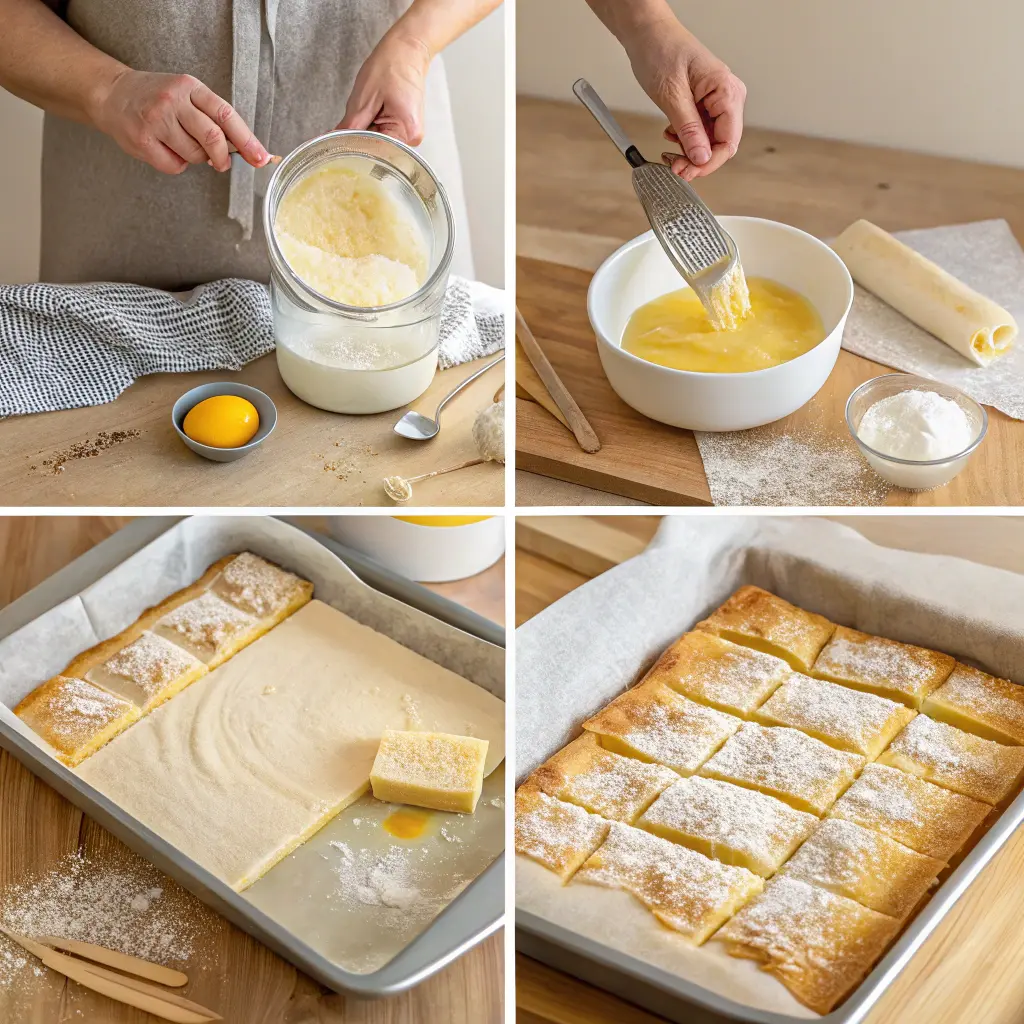
Golden Bougatsa Delight Around the World
Where to Try Authentic Bougatsa in Greece
If you’re a foodie planning a trip to Greece, Golden Bougatsa Delight needs to be on your radar — especially in Thessaloniki. Known as the pastry capital of Greece, this city serves some of the most beloved bougatsa you’ll ever taste. Local bakeries like Bantis or Giannis have perfected the art, often starting their day with lines of eager customers wrapped around the block.
You’ll also find incredible variations in Serres, the birthplace of traditional bougatsa. There, bakers still use wooden rolling pins and time-honored methods passed down through generations.
Pro tip? Order it hot, with an extra sprinkle of cinnamon sugar. You’ll thank us later.
For travelers in Athens, check out small bakeries tucked into neighborhoods like Psiri or Koukaki — where tourists and locals mingle over flaky slices and iced Greek coffee.
Popular International Adaptations and Fusion Recipes
As Greek cuisine finds its way onto more international tables, creative chefs around the world are putting their own twist on Golden Bougatsa Delight.
In New York and Melbourne, for example, you’ll spot bakery cafés adding citrus zest or serving bougatsa with a dollop of Greek yogurt and honey. Some even go savory, stuffing phyllo with sweet potato custard or chocolate-hazelnut spread.
From brunch menus in hip cafes to fusion dessert bars, this golden treat is becoming a global star — and it’s no wonder. That balance of crisp and creamy hits the sweet spot every time.
For more delicious recipes, check out our latest dessert creations at FamilyTimeRecipes.com. You’ll find plenty of sweet inspiration!
Nutritional Breakdown and Serving Ideas for Golden Bougatsa Delight
Calories, Nutrients, and Allergen Information
Let’s get real — Golden Bougatsa Delight is a rich dessert. But that doesn’t mean you can’t enjoy it in moderation! A standard serving (about 120g) typically contains:
- Calories: ~350
- Fat: ~18g (mostly from butter and phyllo)
- Carbs: ~40g
- Protein: ~5g
- Sugar: ~15g
It’s high in carbs and fats, thanks to the semolina custard and buttery phyllo dough. However, it’s also a source of quick energy — which is why it’s often eaten in the morning in Greece.
Allergen note: Contains gluten, dairy, and eggs — so those with sensitivities should be mindful. Want to make it friendly for more diets? Use plant-based milk, dairy-free butter, and gluten-free phyllo sheets.
Serving Suggestions: With Coffee, Ice Cream, or Fruit?
The best way to enjoy Golden Bougatsa Delight? Straight from the oven — warm, golden, and dusted with cinnamon and sugar. That’s the classic way.
But if you want to mix things up, here are some delicious pairings:
- With coffee: It’s practically made for a Greek frappe or espresso.
- With vanilla ice cream: Hot and cold together? Pure dessert harmony.
- With berries or figs: The tartness of fresh fruit cuts through the richness.
- With honey drizzle: A simple yet authentic Greek topping twist.
Hosting a brunch or dessert bar? Slice bougatsa into squares, sprinkle with powdered sugar, and serve on a rustic wooden platter. Your guests won’t stop at one.
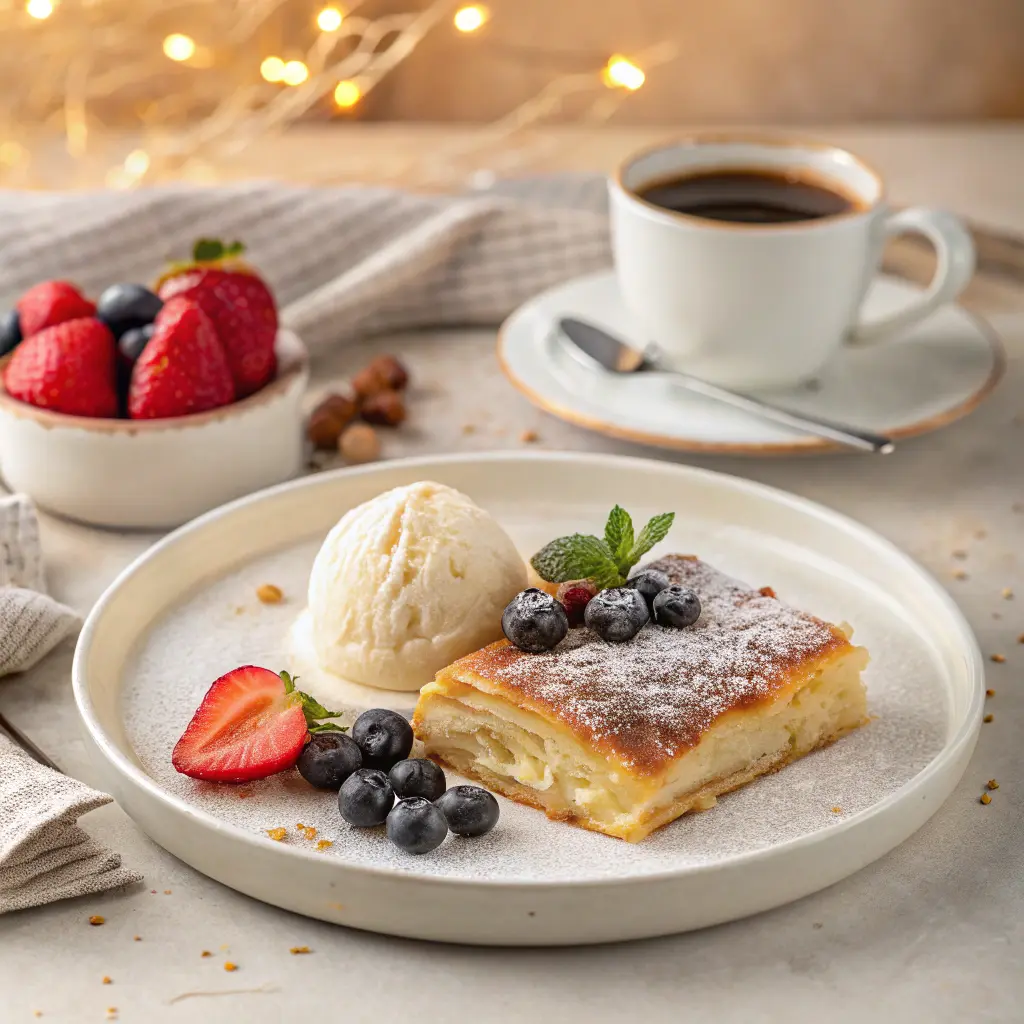
History and Evolution of Bougatsa
Byzantine Roots and Ottoman Influence
To truly understand Golden Bougatsa Delight, we need to take a little trip back in time — all the way to the Byzantine Empire. Bougatsa began as a simple filled pastry, often stuffed with cheese, meat, or sweetened semolina custard. It was an everyday food, popular among workers, travelers, and street vendors.
Later, during the Ottoman era, the pastry spread across the empire and evolved into the version we know today. The word “bougatsa” itself comes from the Ottoman Turkish word pogatsa, meaning pie or filled dough. Thanks to cultural exchange, it traveled from Constantinople to what’s now northern Greece.
Cities like Serres and Thessaloniki embraced bougatsa and refined it over the centuries. Greek bakers introduced new techniques, like stretching the phyllo until paper-thin and crafting the creamy semolina custard that defines sweet bougatsa.
Through generations, the dessert became a breakfast favorite and an afternoon pick-me-up — always served fresh, warm, and golden.
Why It’s Still a Greek Breakfast Staple Today
Despite being centuries old, bougatsa hasn’t lost its charm. In fact, Golden Bougatsa Delight remains one of Greece’s go-to comfort foods. From early-morning bakeries to family-run cafés, it’s a must-have pastry that starts the day off right.
Part of its lasting appeal is the balance it offers — it’s light yet filling, sweet but not cloying, crispy outside and creamy inside. Plus, it’s super affordable, making it a popular choice for students, workers, and tourists alike.
And let’s not forget: it pairs perfectly with a strong cup of Greek coffee. What’s not to love?
The Secret Behind the “Golden” in Bougatsa
What Makes It Golden: Butter, Technique, or Legend?
The color of Golden Bougatsa Delight isn’t just beautiful — it’s symbolic. That warm, golden-brown top comes from layers of butter-brushed phyllo baked to crispy perfection. But there’s more to it than meets the eye.
Many believe the “golden” title also reflects its prized status in Greek cuisine. It’s a treasured treat, and for good reason — every bite delivers that rich, luxurious texture that melts in your mouth.
Skilled bakers also rely on timing and temperature. Bake it too long, and it dries out. Not long enough? No crisp. The trick lies in balancing high-quality butter, fresh phyllo, and the right oven heat to achieve that signature golden glow.
Symbolism of Golden Color in Greek Desserts
In Greek tradition, golden hues often symbolize abundance, celebration, and joy. So it’s no surprise that the Golden Bougatsa Delight shines — literally and metaphorically — during holidays, brunch gatherings, and cozy family mornings.
It’s more than a dessert. It’s a celebration in every slice.
FAQs About Golden Bougatsa Delight
What is Golden Bougatsa Delight made of?
At its core, Golden Bougatsa Delight is made from flaky phyllo dough filled with creamy semolina custard. It’s baked until golden brown and topped with powdered sugar and cinnamon. Simple, yet unforgettable.
Is Bougatsa a dessert or breakfast?
Interestingly, it’s both! In Greece, many people enjoy bougatsa first thing in the morning. However, thanks to its sweetness, it’s also served as a dessert — often warm, right out of the oven.
Can I make Bougatsa without phyllo dough?
Technically, you could use puff pastry or other doughs, but it won’t have the same crisp, layered texture. For the real Golden Bougatsa Delight experience, phyllo is a must.
How do you reheat Bougatsa and keep it crispy?
The best way? Pop it in the oven at 350°F (175°C) for about 8–10 minutes. Avoid microwaving — that’ll make it soggy. A quick oven reheat restores that golden crunch!
Golden Bougatsa Delight vs. Similar Pastries
Bougatsa vs. Galaktoboureko: What’s the Difference?
Both desserts may seem alike at first glance — they’re Greek, custard-filled, and wrapped in phyllo dough. But there’s one key difference: Galaktoboureko is soaked in syrup after baking, while Golden Bougatsa Delight stays dry and flaky on the outside.
Galaktoboureko’s custard also tends to be a bit richer and sometimes more pudding-like. In contrast, bougatsa’s semolina filling is lighter and slightly grainier, giving it a different mouthfeel. Plus, bougatsa is usually dusted with sugar and cinnamon, not drenched.
So, while both are delicious, Golden Bougatsa Delight stands out with its perfect contrast of crisp pastry and airy custard.
How Does Bougatsa Compare to Baklava and Mille-feuille?
Baklava is much sweeter and nut-based, layered with honey syrup and crushed walnuts or pistachios. Mille-feuille (the French cousin) features puff pastry and pastry cream but lacks bougatsa’s warm, custardy simplicity.
What sets Golden Bougatsa Delight apart? It offers a cozy, home-baked feel that’s less sugary than baklava and less fussy than mille-feuille — making it the perfect blend of comfort and elegance.
If you’re a fan of custard-filled pastries like Golden Bougatsa Delight, you’ll also enjoy these rich and indulgent Strawberry Cheesecake Stuffed Donuts — they’re just as creamy and satisfying!
Print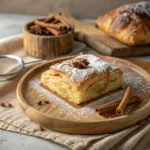
Golden Bougatsa Delight – A Flaky Greek Dessert You’ll Fall in Love With
- Total Time: PT55M
- Yield: 8 servings 1x
Description
A traditional Greek dessert made with layers of buttery phyllo dough and creamy semolina custard, dusted with cinnamon and powdered sugar.
Ingredients
-
1 package phyllo dough (thawed)
-
4 tbsp unsalted butter (melted)
-
½ cup fine semolina
-
2 cups whole milk
-
¾ cup sugar
-
2 eggs
-
1 tsp vanilla extract
-
Cinnamon and powdered sugar for topping
Instructions
-
Heat milk and semolina in a saucepan until thickened.
-
In a separate bowl, whisk eggs with sugar and vanilla, then mix into the custard.
-
Layer phyllo sheets in a buttered dish, brushing each with butter.
-
Add the cooled custard and fold over the edges. Top with more phyllo.
-
Bake at 350°F (175°C) for 35–40 minutes until golden brown.
-
Let cool slightly, then dust with powdered sugar and cinnamon. Slice and serve.
- Prep Time: PT15M
- Cook Time: PT40M
- Category: Breakfast
- Cuisine: Greek
Nutrition
- Calories: 350
- Sugar: 15g
- Sodium: 90mg
- Fat: 18g
- Saturated Fat: 10g
- Carbohydrates: 40g
- Protein: 5g
- Cholesterol: 65mg
Keywords: Golden Bougatsa Delight, Greek custard pastry, semolina dessert, phyllo dough dessert, bougatsa recipe

